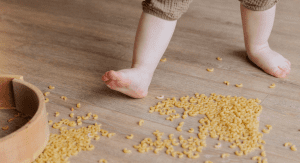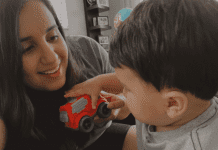
In my years as a pediatric physical therapist, one of the questions I get asked most often is, “Does my child have flat feet?” Here’s a quick guide to normal foot development, and how to tell if your child’s feet could use a little extra arch support.
Normal Foot Development
Baby feet are very flexible and have a fat pad covering the area that will eventually develop into an arch. As they begin to stand and put weight through their feet, babies build strength in their foot muscles and joints. When they start walking around 1 year of age, children normally appear flat-footed. The medial arch of the foot begins to lift away from the ground around 2 years of age and continues to develop until about age 6. So, in a technical sense, flat feet are “normal” for young children. However, sometimes children have excessively flat (or pronated) feet. Overly pronated feet can cause foot, knee, or hip pain over time if left untreated.
Signs of Excessively Flat Feet
- No visible arch after 3 years of age. Between the ages of 2-3, you should be able to start seeing some “space” between the floor and the inside of your child’s foot. If the middle of their foot stays in contact with the ground, this can indicate excessively flat feet.

- Heel tilts inward. If you look at feet from the back, the middle of the heel (use the Achilles tendon as a reference point) should be nearly vertical. Imagine a clock face, where the leg is 12 o’clock. The heel should be pointing to 6 o’clock (or fairly close to it). If you see most of their weight on the inside of their foot, or the pinky toe lifting off the ground, this is a pretty good sign they are “rolling in” with their feet.

- Toes angle away from the rest of the foot. Our toes should extend straight out, in line with the borders of our feet. When kids have too much pressure on the inside of their feet, they often compensate by trying to grip the floor with their toes. This can cause their toes to angle away from the border of the foot, and eventually lead to bunions.

What Should I Do?
If you suspect that your child has excessively flat feet for their age, talk to your pediatrician. You should take your child to see a pediatric physical therapist or a pediatric podiatrist, who can recommend appropriate arch supports. It is important to not only support the foot with shoe inserts but also strengthen the foot muscles responsible for arch development. Untreated flat feet can lead to delays in gross motor skills and possibly pain, but with the right tools, you can set your child up for success and prevent potential problems down the road.

















